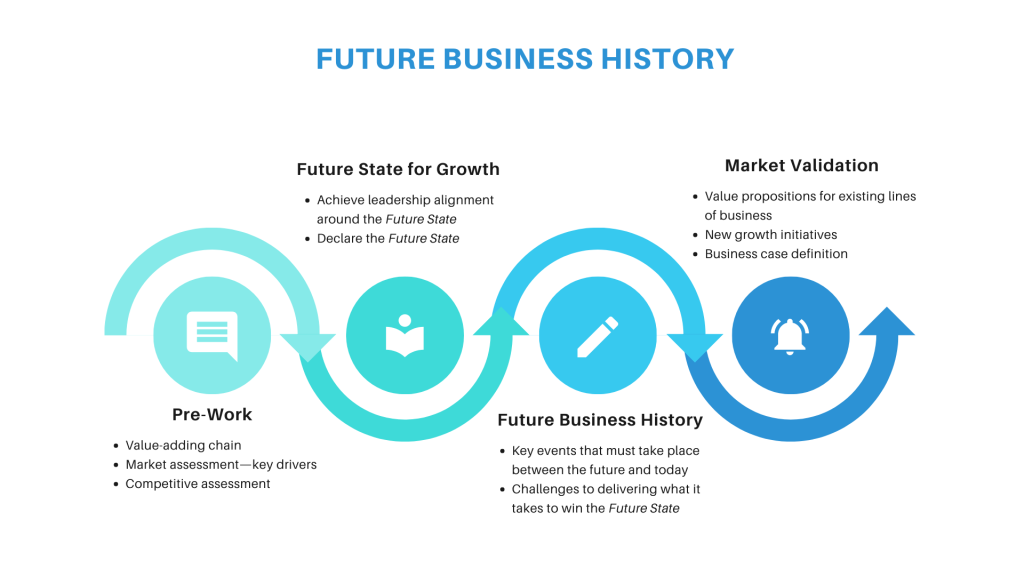Market Facts or Leadership Gut Feelings—Which Deliver Sustainable Growth?
Many business leaders have tried continuous process improvement, Lean Six Sigma, and Agile to improve their business’s operational, sales, and engineering processes, but have failed. These methods are all about the internal world of the business. However, business transformation goes well beyond internal changes; the external market also gets a vote.
We go external by doing market research to determine the market’s needs and wants. Then, we recommend business transformations supported by internal and external research. In doing so, we advocate not just for revising or creating new internal processes, but also for new business approaches to the market.
Why Can't We Grow Our Business?
Agile as a Foundation for Internal Change
Regardless of the growth process your company uses, Lean Six Sigma generally contains four distinct arenas of activity:
Research shows that market validation issues rank the highest among all reasons for growth project failures. We advise, teach, and coach clients in the use of Lean Six Sigma to make applying marketing process (including market research and analysis) more effective.
We apply Lean Six Sigma tools and methodologies to better
- Define the market opportunity
- Develop the value proposition
- Measure how your customers’ perceive the value of your product
- Describe the forces that could impact your concept
- Build the value-price strategy
- Generate product positioning and motivating messages(s)

Define the success you want to achieve as a future state, then investigate the external factors that drive the transformation you are trying to achieve. Invariably, this requires your organization to change the way it thinks and acts, and to use the best tools that are necessary to achieve that.
The way an organization thinks is the change in its culture; the way it acts is its ability to work using the right tools. The proliferation of digital tools that connect and integrate data optimizes decision-making, which saves resources—people, money, and time. Being able to act on the data decreases the number of hours it takes to make a decision, increasing profitability. In today’s world, that is both easier and harder. It is easier because there are tools to make the work more effective and efficient, but it is harder because the tools are more sophisticated and require a different learning curve.
We have developed a full complement of coursework specifically for marketers—in their language and applicable to the work that they do. Our coaching ensures that real learning and business improvement take place.
SWEEP™ Through to Success
We are known for go-to-market plans that grow revenue and reduce launch times. SWEEP™, or Strategic Work-Enhanced Efficiency Processing, is our signature 9-step process to complete the workflow that aggregates the sequential tasks or milestones on your road to success. With SWEEP, we work to take you from being a transaction limiter to a transaction enabler.
Reduce Risk with MORE℠
Not happy with where you are? Want to operate in a different market space? Are you asking yourself in which market space you want to be and what must you do to win in that new space?
You can start with your intuition about where opportunity could exist. But more is needed.
Our MORESM (Marketing Optimized with Research and Evaluation) tool reduces the risk associated with investing in new offerings. We save you time, resources, and costs with our efficient approach to defining what will sell, to whom, and for how much before you direct resources into a new line of business.
MORE delivers a fast-based description of how the market will value and purchase your innovation. We identify how you can drive revenue with the customers you want to serve faster. You achieve your business goal of more profitable revenue with a more efficient investment.
To start exploring potential new spaces and answering the question “What do I need to do to get there?” you need a plan. You need to understand the market topography to map your path forward. MORE is a proven tool that uses data generated from customized, primary research to reveal the contours of the road that will lead to your success. MORE helps you think back from a vision of your future and determine what you need to do to get there.
You can document your future state and answer the question “What has to happen for me to get there?” using our Future Business History. There’s a large and definable space in the future if you can just envision what is on the edge of doable. Aim for a specific future state to identify a new product or service customer not buying your offering today. Current customers—who will buy your new offering based on their wants and needs that are not being satisfied—can become part of that new customer group too. This future state may require you to build a new business model to capture value from them.
When you think about new products and services, you can offer what exists today with incremental improvements, delivering to those customers who know and respect you as well as to a whole new set of customers who need just that extra set of benefits to buy. The most challenging future state, though, is one in which you go beyond the incremental and offer significant newness or innovation to a new group of customers–those who don’t already know you. That is the riskiest road to travel. But it has the potential to deliver the greatest reward. The challenge is how to capture that reward in the most efficient and effective way possible. It all starts with a picture of a future state that is so clear, so real that the process of building the history that got you there becomes an exciting and feasible road to travel. MORE helps you with the hard part.
Future Business History℠

Future Business History℠ is part of a process designed to lead a business through developing a vision and an aggressive growth strategy. The approach is based on a highly interactive framework that transforms the Future State vision into
- A strategic intent
- Core strategic architecture with operating strategies
- Key actions required to get started
- An organizational model linked to the strategic intent
The set of targeted actions (on a timeline) and success measures comprise the Future Business History.
The process to make strategic product and marketing decisions starts with your internal vision and adds insights into what your target markets will value. We characterize the behavioral and emotional responses customers have and will have to products, services, and individuals. Thus, marketers receive the information they need to generate compelling benefits, value propositions, and positionings that go beyond functional appeals. So, communications and offering design are more targeted and impactful, because they address the unique triggers necessary to establish preferences and the desired customer behaviors.
Cultural Transformation
There are four challenges business leaders must face when undergoing a cultural or digital business transformation.
Get real commitment
Do you find that within your business, trends and ideas are discussed, but the commitment needed for success is missing? The first challenge is getting real commitment and executive sponsorship. Lack of sponsorship—or lots of talk but little to no serious action—puts initiatives at risk from the start. You need real commitment to invest and innovate, as well as support from top executives.
- Build and communicate your business case, highlighting value derived through digital transformation.
- Realistically identify resources needed and align with clear objectives.
- Develop governance, metrics, and mechanisms to measure and communicate progress.
Foster a Truly Innovative Culture
The second challenge is fostering a truly innovative culture. A true cultural transformation requires a faster pace to tinker, try, and experiment. Business leaders say they want to innovate, but their employees know failure is not tolerated. There are no rewards for experimenting. To be a powerful leader, you need to foster innovation. Encourage creativity and risk-taking by adopting a “test, fail, learn” culture.
In other words, you need to align your business culture with the fast-paced Silicon Valley culture.
- Assess cultural readiness and change the way people think, so that new behavior follows.
- Seed and cultivate innovation and reward learning.
- Build a culture that accepts failure for learning.
- Develop and nurture innovation networks.
Build a Collaborative Organization
The third challenge is building a collaborative organization. This requires an outward approach to listening, learning, and leveraging information. Inwardly-focused employees may have a heads-down awareness of what goes on only in their own department, leading to short-term vision. Instead, business leaders need to empower employees to think collaboratively and engage with colleagues, customers, and the outside world.
- Expose and build empathy for customer experience.
- Rethink old and outdated processes.
- Use innovative thinking workshops to jumpstart creativity.
Anticipate Trends and Respond with Agility
The final challenge is anticipating trends and responding quickly. Trends and technology continue to change, as does the competitive landscape. Many organizations are resistant to change or slow to adopt new ideas. The desired state for the future is open and agile.
- Engage your team in new thinking and adapting to disruptive business models.
- Develop emotional intelligence.
- Monitor, learn, test, and adapt, ensuring a continuous feedback loop.

Related Insights

The Power of a Clear Value Proposition for Small Business Growth
A fact-based value proposition aligned with customer experience can drive growth and loyalty for your small business.

Small Business Growth Strategies for Lasting Success
Learn effective small business growth strategies focused on market-driven innovation, customer insights, and sustainable success.

If You Don’t Want to Stagnate, You Need to Innovate
It’s not news that innovation and new product offerings are the keys to growth for the most successful companies. But the road from concept to commercialization is fraught with risks.


